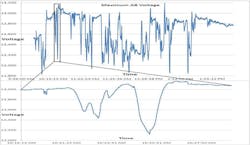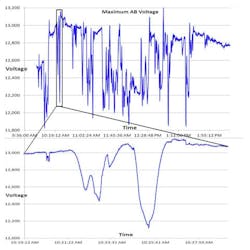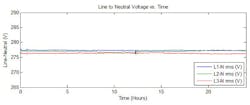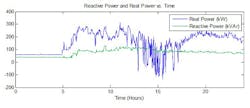Solar Power Impacts Power Electronics In The Smart Grid
Solar PV’s intermittency, in combination with other factors, leads to voltage variability on distribution feeders, yet utilities have an obligation to maintain voltage within 114 to 126 volts all along those lines to meet ANSI standards. Voltage variability triggers the operation of electro-mechanical devices designed for voltage regulation (and that act based on voltage changes, not timers) – from load tap changers (LTCs) at the substation, to voltage regulators out on the feeder – far more frequently than intended by their original design. In turn, that higher number of operations dramatically shortens those devices’ lifecycles, without necessarily resolving the variability, leading to unanticipated costs and a search for mitigating technologies.
This domino effect of high-penetration solar PV on voltage variability and voltage regulation devices’ reduced lifecycles has been identified and is being addressed at San Diego Gas & Electric (SDG&E) in Southern California and Arizona Public Service (APS) in central Arizona. Yet there’s reason to believe these effects are also taking place at utilities that simply aren’t examining feeder voltage data in highly granular form and remain unaware of the issue.
In any case, the high-penetration of solar PV – aided by federal and state policies and the declining cost of PV panels – and its aforementioned effects is a nascent trend that will inevitably become more widespread in the United States. It behooves utilities to understand and anticipate these impacts prior to addressing the symptoms, because many factors affect the selection and application of mitigating technologies. While the effects may be generalized, the solutions and their precise applications are likely to be specific to each utility. (It’s worth noting that the trend is already commonplace in Europe, where the policy framework that encourages high-penetration of solar PV also requires inverters that provide reactive power compensation.)
The search for mitigating technologies ranges from the conventional, such as re-sizing feeder lines and installing dynamic VAR (Volt-Ampere Reactive) devices, to the unconventional, which includes energy storage and the application of power electronics to technologies that today rely on electro-mechanical means of operation. In fact, the overall subject highlights why, in my view, the currently separate disciplines of power electronics and power system automation ought to be integrated.
VOLTAGE VARIABILITY
As intermittent solar power is interconnected to the distribution system – especially at times of low load, high PV output and variable atmospheric conditions – the result can be voltage variability on the specific feeders hosting the PV. Analysis of this effect by GE Global Research, based on data from both SDG&E and APS, reveals that both the voltage variability and the effectiveness of a variety of mitigating technologies can vary based on characteristics such as the location of the PV on the feeder, as well as feeder length and conductor size.
The traditional, electro-mechanical devices that typically handle voltage variability, from the substation’s LTCs to dynamic voltage regulators along the feeder, weren’t designed to handle the new level of variability. That’s why, in my view, power electronics-assisted devices will see greater demand.
For instance, LTCs designed to operate several times each day may be triggered by solar PV-induced voltage variability to operate with greater frequency, reducing the expected lifecycle of this costly component from 30 years to as little as 5 to 10 years. The introduction of power electronics in this context to reduce the number of mechanical operations to within a device’s design parameters may well provide a solution, though cost remains a concern at this pre-commercial stage. Other mitigating technologies, some of which also rely on power electronics, are being explored.
SUNNY SAN DIEGO AND COASTAL FOG
Because the causes, effects and mitigation of high-penetration solar PV are best understood under location-specific circumstances, let’s look in turn at both SDG&E’s and APS’ approaches to quantifying the issues and field testing possible solutions. Once we set the scene, we’ll address the evolving definition of “high penetration” solar PV as it applies to these examples.
In San Diego, affluent homeowners along the coast have installed solar PV arrays in large numbers, according to Tom Bialek, chief engineer at Sempra Energy, owner of SDG&E. The “coastal marine layer” – fog, that is – typically burns off by midday, when the PV arrays ramp to maximum output. Due to an ocean breeze, coastal homes aren’t usually equipped with air conditioning, thus their service panels are likely limited to 100 amps. That means that as many as 20 homes are served by a single distribution transformer. All these factors contribute to spikes in voltage variability when PV output is high, load is low, voltage regulation is electro-mechanical and, possibly, there’s high impedance on the feeder, Bialek told me recently.
The drivers of residential solar PV uptake in SDG&E’s service territory include federal and state incentives and the abundant solar resource, while affluent homeownership along the coast leads to the phenomenon of clustering. These factors could and probably will impact other areas of the country in time, according to Lee Krevat, director of smart grid initiatives at SDG&E.
“The problem of the future is a problem of the present,” Krevat told me. “There’s an urgency around finding a solution.”
In another example, further inland, an avocado farm near the end of a long feeder installed a substantial PV array to offset the operation of irrigation pumps. California requires SDG&E to accommodate that interconnection. Morning fog burns away and solar PV output rises after the pumps typically operate in the morning. With net metering policies in place, the farm injects substantial amounts of power onto the feeder, creating a voltage differential that results in reverse power flows. That, in turn, leads to the maximum tap, then lockout, of an upstream voltage regulator and has even affected voltage on the primary distribution line.
The top portion of Fig. 1 illustrates one second voltage variability on one 12 kV feeder, dubbed “C520,” out of Avocado Substation over an approximately 4 ½ hour period in San Diego Gas & Electric's distribution system, due to the fog burn-off over a 1 MWac solar photovoltaics system on a small commercial premise. The bottom portion of Fig. 1 breaks out an approximately 10 minute portion of that 4 1/2 hour period, illustrating the magnitude of voltage swings in that 12 kV line.]
SDG&E has installed monitoring equipment at a variety of sites to gather data on the causes, effects and locations of the resulting voltage variability in these two cases. The urgency to developing mitigation strategies cited by Krevat is driven by quantifiable trends in solar PV uptake. The U.S. Department of Energy’s SunShot Initiative is aimed at bringing solar PV costs down to $1 watt by 2020. State-level incentives are also at work, as are third parties that finance and install PV arrays based on the contagious notion that solar PV cuts utility bills while it helps the environment.
The result? Currently, in SDG&E’s territory, a total of 24,000 PV installations produce about 175 megawatts, Bialek told me. Year-on-year growth of PV installations in SDG&E’s service territory is 30 to 40 percent; the number of installations is doubling every two years. Third parties facilitate about 70 to 80 percent of new installations. According to California Energy Commission projections, continued growth of solar PV is certain. A handful of SDG&E’s circuits today have greater than 30 percent PV penetration. Most PV systems are designed for maximum output with little regard for their effects on the grid; i.e., VAR support. (More on that angle in a moment.)
“The reality is that we’re seeing areas with even higher-than-projected PV growth, and not evenly spread across our service territory,” Krevat said.
APS GETS AHEAD OF THE CURVE
Arizona Public Service’s Community Power Program in Flagstaff is an ongoing effort to anticipate how high penetration of solar PV will affect the stability of its grid and how to mitigate those impacts. The project is primarily funded by $2.7 million from the U.S. Department of Energy that includes $520,000 from the National Renewable Energy Lab (NREL) and is conducted by a consortium of partners, including APS, GE Global Research, NREL, Arizona State University and private contractors. APS sought approval from its regulator, the Arizona Corporation Commission, and received it. APS gathered baseline data on feeders in Flagstaff that demographics suggested would be early and enthusiastic adopters of residential solar PV. Then it installed about 1.5 megawatts of PV among volunteer homeowners and schools to measure the effect on voltage variability.
On a side note, GE Global Research helped APS design and implement what may be a unique data collection system that ran in parallel to and could be accessed by the utility’s SCADA system to detect and record voltage variability. The “separate but parallel” aspect answered cyber security concerns.
⨓High-Penetration” Solar PV
Before we go any further, let’s articulate the evolving definition of “high-penetration” solar PV. According to Kathleen O’Brien, manager of the Electric Power Systems Laboratory at GE Global Research, that definition has shifted as studies have brought a degree of precision to the issue.
“The ‘old’ definition, in 2008, when some anticipated PV penetration soaring in the near-term, was that ‘high penetration’ of PV meant a certain percent of total power on any balancing area,” O’Brien told me recently. “Because the impact of PV is seen locally first, a better definition focuses on distribution-connected solar PV on a single feeder. The question today is ‘what percent of load is served by PV on the feeder itself during peak hours, such as a sunny day in winter, when there’s low load and the sun is shining?’ For example, a feeder with 80 percent of load served by PV at that time is considered ‘high penetration.’”
SDG&E’s definition is similar, according to Bialek. When the ratio of PV nameplate AC output to the load on the circuit is high – i.e., when PV output peaks and load is low – reaches 30 percent, SDG&E has a concern, according to Bialek. That often occurs at midday in April-May, when the sun is shining but no air conditioning is running. But, as noted earlier, the degree of penetration can change based on time of day, location and feeder characteristics, Bialek said.
“The impact on the system itself becomes a function of where it’s located, proximity to the substation and conductor sizes,” Bialek added. “Factors include the load immediately surrounding the actual PV system and the size of that system. A number of factors drive the impact.”
It may be useful to keep the elusive nature of “high penetration” solar PV in mind as we turn to mitigating technologies, which range from conventional to unconventional, from tried-and-true to power electronics-assisted components now emerging from the lab to field test.
SEARCH FOR SOLUTIONS
At SDG&E, Bialek described potential, mitigating technologies as residing on a continuum from conventional to unconventional. Perhaps unsurprisingly, costs increase from tried-and-true to less-tested solutions. Thus, SDG&E began by changing voltage regulator settings and re-sizing conductors. It soon will test a couple of mega-VAR dynamic VAR devices along selected feeders. At the high end of cost, it has field-tested energy storage at a variety of locations. Re-sizing conductors has reduced the overall magnitude of voltage fluctuations, but not the fluctuations themselves. Storage provides a flexible solution, but the cost is high and the business case for it only pencils out when it serves multiple roles and value streams, which can be challenging to effectively coordinate.
One major, promising solution is the focus of SDG&E’s efforts to have California’s interconnection rules changed, while working with PV vendors: dynamic VAR-equipped PV inverters, if required as they are in Europe, appear to be the least-cost solution directly addressing the source of voltage variability.
Figs. 2 and 3 are a matched set of curves for a 400 kWac PV and 240 kVAr dynamic VAr system installed. Fig. 2 shows the three line-to-neutral voltages on the secondary side of a transformer. While there are some differences in the actual individual phase voltages, it should be noted that the dynamic VAr device is performing well and keeping the secondary voltage ranges very tight. While Fig. 3 shows the real and reactive power on the secondary and show significantly more fluctuation, especially the power due to PV intermittency.]
At APS, the potential for over-switching of capacitor banks and, possibly, an increase in LTC operations, has led to the study of a variety of mitigating technologies, including power electronics-assisted Static VAR Compensators or STATCOM.
POWER ELECTRONICS TO THE RESCUE?
Although we’ve managed to articulate specific challenges in specific circumstances at these two utilities, it’s clear that the challenges and solutions are not uniform. That makes it difficult to deliver definitive statements about the role of power electronics in solutions.
Sharp-eyed readers, however, will note that SDG&E’s dynamic VAR devices are assisted by power electronics. (STATCOMs all rely on power electronics.) Major vendors are doing R&D on prototype LTCs employing power electronics. So, despite the perils of generalization, an underlying challenge is apparent and the nature of power electronics lends itself to a solution.
Some electro-mechanical devices, particularly those with a role in voltage regulation, are ill-equipped by dint of their design to address the speed and magnitude of voltage variability on feeders caused by high penetration of residential solar PV.
Power electronics have the ability to use distributed intelligence to assess many more variables in power quality on distribution feeders and to calibrate a device’s response to minimize automated, mechanical actions. Power electronics also have the ability to react in exponentially swifter timeframes than electro-mechanical devices that can shut down from over-operation in the face of rapid swings in voltage.
While the projected cost of power electronics has been an issue historically, the efficacy of this approach is likely to expand its market, bringing costs down through economies of scale. As we’ve documented, the challenge is real and likely to spread. The role of power electronics in mitigating technologies seems assured.
Today it’s San Diego and Phoenix’ challenge; tomorrow it’s likely to be Peoria’s.



